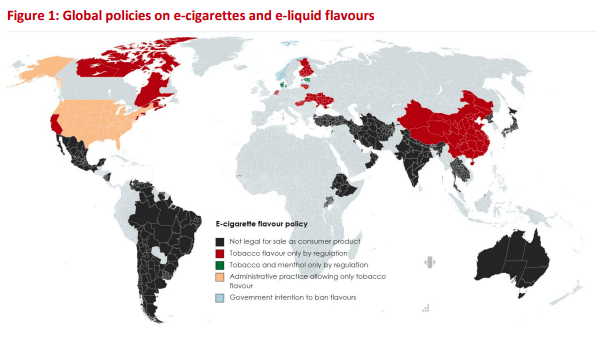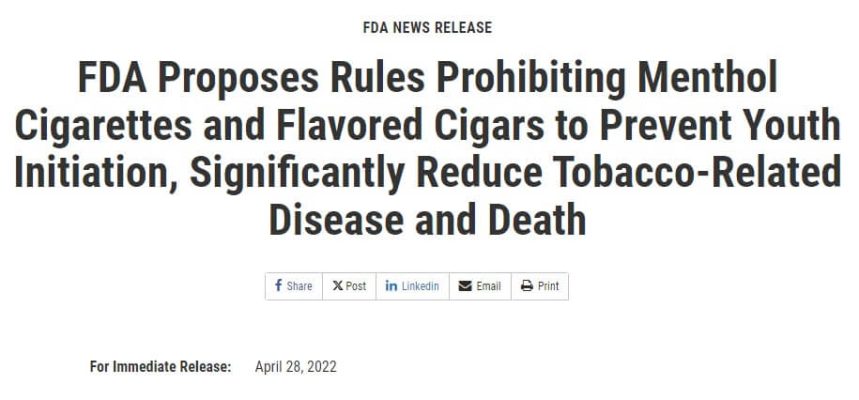
Vapes and HTPs have grown in popularity in recent years and are now available worldwide. But as vapes and HTPs have become more and more popular, people’s attention has been drawn to their possible risks and how they may affect the rates of youth smoking.
In order to deal with this problem, some countries and regions have imitated the cigarette flavor ban and adopted measures to ban the flavors of vapes and HTPs. To address this issue, some countries and regions have taken laws similar to the cigarette flavor ban and banned the flavors of vapes and HTPs.
Flavor bans on vapes, HTPs and cigarettes have become a global trend
Vapes
Over 30 countries do not permit the sale of e-cigarettes as consumer products, and by extension do not permit the sale of flavoured e-cigarettes.
Among the countries which permit their sale, 6 countries have introduced national-level bans on flavors other than tobacco flavour (Finland, Hungary, Netherlands, Ukraine, Lithuania, China), two have banned flavors other than tobacco and menthol (Denmark and Estonia) and two (Canada and the United States) have sub-national restrictions in place.
By administrative practice, the United States Food and Drug Administration has denied marketing orders to e-cigarettes with flavors other than tobacco, and has denied orders to some menthol-flavors. Several other countries have announced an intention to ban flavorings.

HTPs
EU HTP flavour ban to take effect Nov. 23 2022. EU member states than have until July 23, 2023, to transpose the rule into national legislation.

Cigarettes
The European Union banned characterising flavours in cigarettes in May 2020. US FDA proposes ban on menthol cigarettes and flavoured cigars in April 2022 to prevent youth smoking.


Most users are affected by flavor bans on vapes, HTPs and cigarettes
E-cigarettes
One study showed that tobacco was only mentioned by 2.1% of respondents as the most commonly used flavor.
HTPs
There aren’t many surveys on the popularity of HTP flavors. Here is a 2022 online survey provided by Japanese media. The reporter conducted a questionnaire survey on 1,000 IQOS 3 Duo / Multi users from all over Japan. The report shows: 72% of Japanese IQOS 3 Duo / Multi users choose the flavour with menthol.
Reference: 【2022年】IQOS3Duo/MULTIユーザー1,000名に聞いたマールボロとヒーツ人気フレーバーランキング!1位はどちらのスティック?
Cigarettes
According to the latest Eurobarometer report (2017), 8% of EU smokers smoke menthol cigarettes and 7% other flavoured cigarettes. These numbers suggest that a ban on characterizing flavors is likely to directly affect at least one in ten smokers. Within the Members States, menthol cigarettes are most widely consumed in Finland (24%) and Denmark (20%) while younger people are slightly more likely to smoke menthol cigarettes (11%) than the average person.
How does the industry respond to flavor bans?
E-cigarettes
On October 1, 2022, China implemented a flavor ban on e-cigarettes. At the same time, flavored sticks for e-cigarettes have appeared on the Chinese market. This type of e-cigarette flavor stick is composed of capsules, filter cotton, and paper tube. It is attached to the reloadable e-cigarette through a silicone adapter and can restore 90% of the flavor of flavored vapes sold before the flavor ban. Some e-cigarettes with reserved holes do not even require an adapter.

Flavor Sticks
HTPs
Since HTPs are relatively new tobacco products, there aren’t any flavor accessories specially designed for them on the market at the moment. However, flavor cards and flavor drops used in cigarettes can also be used in HTPs due to their similar structure. It is learned that even the flavor sticks used in e-cigarettes can also be used in HTPs. The hollow-bottom capsule flavor sticks can be directly put on the HTPs.

HTP Flavor Sticks
Cigarettes
To get around tobacco bans, some tobacco giants have used a variety of methods, including flavored HTPs, flavored nicotine pouches, cooling agents exempted from flavor ban, flavor cards, flavored drops and so on. These products have their own advantages and disadvantages in terms of effectiveness, price, convenience, etc. Here are some strategies used by some of the tobacco giants:
RJ Reynolds
R.J. Reynolds launched its “California compliant” cigarettes, which contain an artificial, flavourless cooling chemical, when the state’s ban went into effect in December.
Source: RJR uses California as test market for skirting upcoming national menthol cigarette ban
Imperial Brands
For “menthol seekers”, Imperial Tobacco launched new “flavour cards” under its Rizla brand.
Source: ‘Impossible to enforce’: Big Tobacco exploiting loopholes in European menthol ban

Rizla Flavor Card – Source: Rizla’s radical inventions: What might not exist today without Rizla?
Potential Impact of Flavor Bans
Reduce rates of teen smoking
One of the main goals of flavor bans is to reduce youth smoking rates. By limiting attractive flavors, bans could have a positive impact on public health by making young people less likely to start smoking.
Protect public health
The long-term health effects of e-cigarettes and HTPs are still being studied, but there is evidence that the use of them may have negative effects on lung health. Bans on flavors can reduce the risk of public exposure to harmful chemicals while also protecting public health.
Impact on the e-cigarette, HTPs market and industry
The ban may lead to a decline in sales of certain e-cigarette products on the market, and may also prompt the industry to look in other ways for innovation and development.

Challenges of implementing flavor bans
Controversial scientific evidence
There are differing opinions in the scientific community regarding the health effects of e-cigarettes, HTPs and the appeal of flavors to smokers.
Some studies suggest that e-cigarettes may be harmful to health, especially among teenagers and non-smokers. Other studies have shown that e-cigarettes and HTPs can help smokers quit cigarettes and reduce the harm to health caused by cigarettes.
However, more long-term studies are needed to fully evaluate the risks and benefits of e-cigarettes and HTPs.
Black market and illegal products
Strict flavor bans may lead some people to turn to black market or illegal products. These products may not have been tested for safety and may pose greater health risks. Regulators need to step up their crackdown on illegal products while providing alternatives to legal products.
Smokers’ objection
Some smokers may object to a flavor ban because they view e-cigarettes and HTPs as effective tools to help them quit smoking. They may worry that a ban will limit their options and make the process of quitting smoking more difficult.
Innovation and alternative products
The ban may lead some manufacturers to seek innovation and develop other types of products to meet market demand. Smokers may turn to other alternatives, such as nicotine-free e-cigarettes, nicotine pouches, and oral sprays, thereby reducing the effectiveness of the ban.
Regulators need to pay close attention to market changes and adjust policies in a timely manner to respond to the emergence of new products.
Manufacturers and industry objection
Manufacturers and industry may object to flavor bans because they would negatively impact their product sales and profits.
They may take action to overturn or weaken the ban, sucha as lobbying governments and launching legal proceedings. They may advocate self-discipline and self-regulation rather than an outright ban on flavors.
Market Regulation and Enforcement
Specific flavored product prohibition requires effective market surveillance and enforcement mechanisms. To ensure that the ban is successfully enforced, it is necessary to tighten control of sales channels, toughen penalties for violations, and provide enough enforcement resources.
International cooperation and experience sharing
Implementation of flavor bans requires international cooperation and sharing of experiences. Countries can share their implementation experiences and best practices to better address common challenges.

In conclusion
Flavor bans are a contentious topic.
Although there are some controversies and challenges with flavor bans, efforts can be made to address them through strengthening market supervision and enforcement, encouraging the development of innovative and alternative products, increasing international cooperation and experience sharing, rasing public education and awareness, and continuing research and evaluation.
The implementation of the ban requires comprehensive consideration of various factors and the formulation of reasonable and effective policies. This will help protect public health and achieve long-term benefits.
References:
- Restrictions on e-cigarette flavours
- Commission Delegated Directive (EU) 2022/2100 on the withdrawal of certain exemptions in respect of heated tobacco products
- Directive 2014/40/EU of the European Parliament and of the Council of 3 April 2014 on the approximation of the laws, regulations and administrative provisions of the Member States concerning the manufacture, presentation and sale of tobacco and related products and repealing Directive 2001/37/EC Text with EEA relevance
- FDA Proposes Rules Prohibiting Menthol Cigarettes and flavoured Cigars to Prevent Youth Initiation, Significantly Reduce Tobacco-Related Disease and Death
- Patterns of flavored e-cigarette use among adult vapers in the USA: an online cross-sectional survey of 69,233 participants
- 【2022年】IQOS3Duo/MULTIユーザー1,000名に聞いたマールボロとヒーツ人気フレーバーランキング!1位はどちらのスティック
- Ban on menthol cigarettes: European Union member states shall prohibit the placing on the market of tobacco products with a characterising flavour
- RJR uses California as test market for skirting upcoming national menthol cigarette ban
- ‘Impossible to enforce’: Big Tobacco exploiting loopholes in European menthol ban